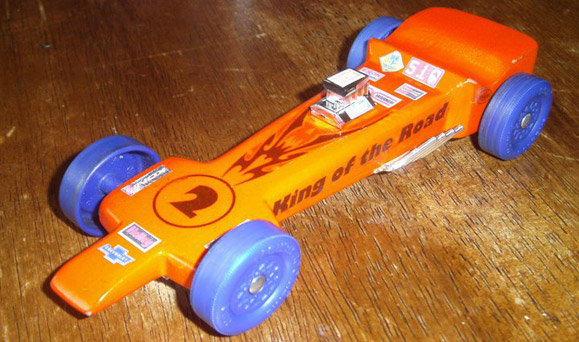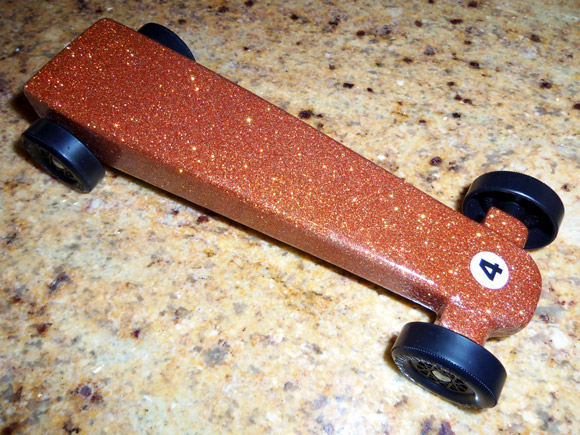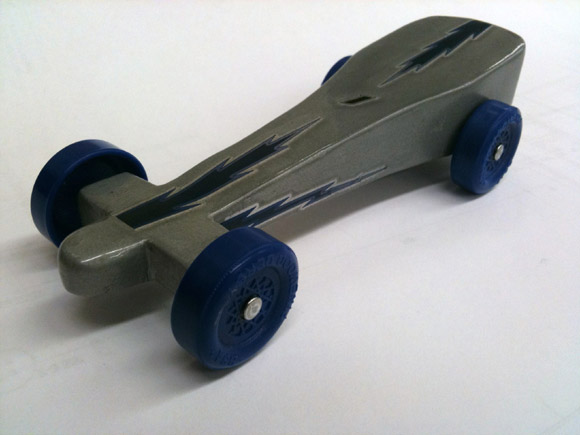– Feature Article – Lubricant Testing: Part 2
– Pinewood Derby Car Showcase
– Q&A
Lubricant Testing – Part 2
By Randy Davis
On February 4, 2009, I published an article on a lubricant test using the “Tilted Plane” method for measuring a friction angle, from which the coefficient of friction (μ) can be calculated. That experiment compared Max-V Lube with MS2 and TS2, and debunked some of the hype surrounding those lubes. You can read the article Here
Since then I have collected a few more lube samples, so I decided to pull out the testing apparatus and go another round.
Lubes
The first lube of interest was Boron Nitride. Boron Nitride is a common industrial lube used (among other things) as a mold release agent, and as a coating for bullets. It is a white powder with an appearance like powdered sugar.1 The two versions I had for testing had a 1.0 micron and 10 micron particle size respectively. These lubes were compared with Max-V Lube graphite.
I also had two types of Methyl-Silicone, a 5 cSt and a 10 cSt version.2 Silicone is often suggested as a good lube for pinewood derby cars. In my experience this is true; however, I have found that silicone lubes tend to last for only a short period of time, limiting the usefulness of the lube for pinewood derby racing. However, I decided to give it another try. The Methyl-Silicone lubes were compared with Krytox 100 (5.14 cSt at 40 deg C).
Experiment Setup
The tilted plane apparatus is shown in Figure 1. The crank causes the glass surface to slowly tilt, while the angle measuring device shows the current angle. For sliding blocks, Delrin plastic was machined into blocks of the same size and weight, with very smooth and flat surfaces on two sides. Separate blocks were used for each of the lubes.
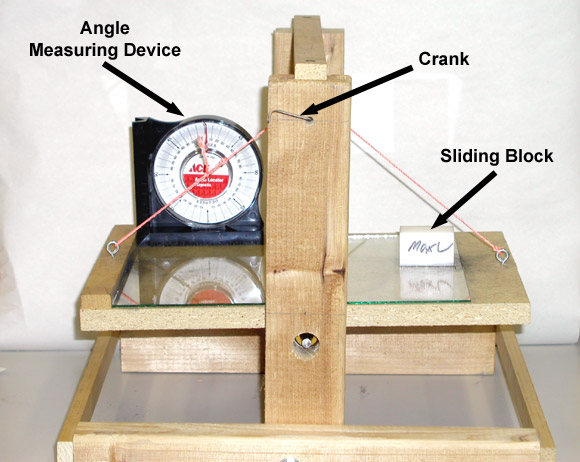
Experimental Procedure
The glass plate on the tilting apparatus was first cleaned thoroughly with a glass cleaner, then with water. This cleaning was repeated each time the lubricant was changed.
For the dry lubes, a quantity of the lubricant was placed on a sheet of clean paper. One side of a block was then rubbed on the lubricant until thoroughly coated. The block was then placed on the glass and slid back and forth to distribute some of the lube onto the glass. The block was then recoated with the lube and placed on the uphill side of the glass.3 The glass was then slowly tilted until the block slid to the downhill side of the glass. The tilt angle was then recorded. This test was repeated five times for each block.
For the liquid lubes, one surface of the block was coated with the lube, and then wiped off with a clean rag. The block was then placed on the glass and slid back and forth. The glass was then slowly tilted until the block slid to the downhill side of the glass. The experiment then proceeded as with the dry lubes.
Experiment Results
After all of the tests, the results were averaged. μ was then calculated for each of the lubricants and for the control block. The results are shown in Figure 2.4
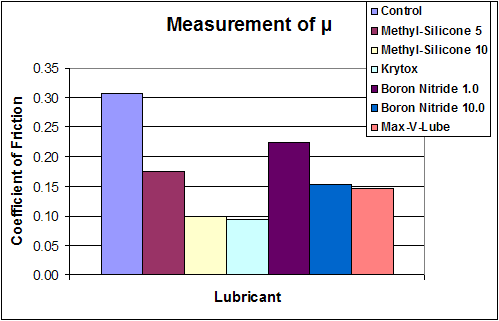
Some observations:
- Both Boron Nitride lubes clumped up, causing poor performance. However, after wiping off the excess, the 10.0 micron version rivaled Max-V lube. But the 0.1 micron version performed poorly, probably due to a continued clumping problem.
- Like graphite, the Boron Nitride lubes were quite messy. However, they did clean up much easier than graphite.
- Methyl-Silicone 5 worked well for the first two trials. Then the lube started to evaporate, resulting in increasingly poorer performance.
- Methyl-Silicone 10 had a performance similar to Krytox 100. However, it also began to degrade after the first two trials.
Conclusion
There does not appear to be any advantage to methyl-silicone over Krytox 100. The evaporation rate of the silicon lube is just too fast for pinewood derby racing.
However, Boron Nitride might be useful as a pinewood derby lube for races requiring a white lube. I did a few weighted-wheel spin tests on a wheel lubed with Boron Nitride 10 (applied with a pipe cleaner through the bore). It spun reasonably well, but more testing would be needed to ascertain whether the lube would be a good choice. One disadvantage is that the raw cost of Boron Nitride 10 is considerably more than graphite.
1Boron Nitride is not to be confused with the “Dry White” lube offered by PineCar and others. Dry White is a PTFE (Teflon) based lube.
2Methyl-Silicone is the main formulation of silicon for use as a lubricant. “cSt” is the abbreviation for Centistroke, a measure of the viscosity of the substance.
3The Boron Nitride tended to clump up on the plastic, which greatly increased the tilt angle. So, before sliding, the excess had to be wiped off.
4The Delrin blocks had a different weight than those used in the previously cited experiment, so the results cannot be directly compared (μ changes with weight).
Car Showcase
King of the Road – Monte & Bryson Evans
Here is Bryson’s car that took fourth place. My son and I built two cars from the ground up – together. This year, we hope to do even better!
Wedge GT – Travis Burkhardt
This Wedge GT took first place in the den. We used Krylon Orange Glitter Blast and many coats of clear.
Silver Bullet – Layton & Brian Grissom
This is my son Layton’s first pinewood derby car.
Q&A
Is there any advantage to lowering the front end of the car by drilling the front axles slightly higher on the block than the rear axles?
As long as you meet the 3/8 inch clearance specification, there is a very slight advantage to lowering the car body. The purpose is to lower the center of gravity of the car. If you just lower the front wheels, there would likely be little effect as the COG is usually closer to the rear of the car.
I notice most of your kit cars have precut areas to attach weight on the bottom of the car. From my research it is recommended the weight be placed as high as possible. Are you seeing the same performance in speed with the weights down low?
I am not sure where you read that high weight is better, but that is not really true. Low weight provides more potential energy and better stability.
You can read more at about weight placement Here. Look for the section “Vertical COG – Up And Down”
Can I add flat magnets for the weight needed, or will it cause the car to be disqualified?
I would avoid magnets. It is possible that they could be considered a starting device if the starting peg is made from steel. Also, if there are any metal screws in the track, the attraction could affect the performance of the car.
Want Answers?
Do you have a pinewood derby-related question? If so, e-mail us your question.We answer all questions by e-mail, but not every question will appear in the Q&A section of the newsletter.
Back Issues
Are you a new subscriber, or have you missed some of the previous newsletters? Don’t miss out; all of the issues for Volume 5 through Volume 17 are posted on our web site.
Newsletter Contributions
We welcome your contributions. If you would like to contribute an article, a web site review, a speed tip, or a pinewood derby memory, please e-mail us.
Subscription Information
The Pinewood Derby Times is a free e-newsletter focused on pinewood derby racing. It is published biweekly from October through March.
If you haven’t already done so, please forward this issue to your pinewood derby friends. But please don’t subscribe your friends. Let them decide for themselves. Thanks.
If this newsletter was forwarded to you, why not subscribe to receive this newsletter. There is no cost, and your e-mail address is safe, as we never sell or share our distribution list.
To subscribe, send a blank e-mail to
[email protected]
You will receive a confirmation e-mail. Reply to the confirmation e-mail and you will start receiving the Pinewood Derby Times with the next issue.
Randy Davis, Editor, Pinewood Derby Times
E-Mail: [email protected]
(C)2018, Maximum Velocity, Inc. All rights reserved. Please do not reprint or place this newsletter on your web site without explicit permission. However, if you like this newsletter we grant permission, and encourage you to e-mail it to a friend.
Maximum Velocity disclaims any personal loss or liability caused by utilization of any information presented in this newsletter.
The Pinewood Derby Times is not specific to, and is not affiliated with the Boy Scouts of America, YMCA, Awana, or any other organization.
(R)Maximum Velocity is a registered trademark of Maximum Velocity, Inc.
(R)Pinewood Derby is a registered trademarks of the Boys Scouts of America.
(R)Awana is a registered trademark of Awana Clubs International.
All other names are trademarks of their respective owners.

